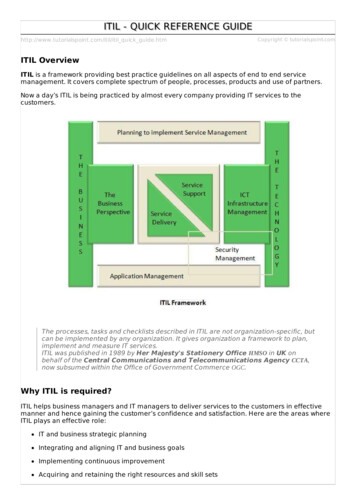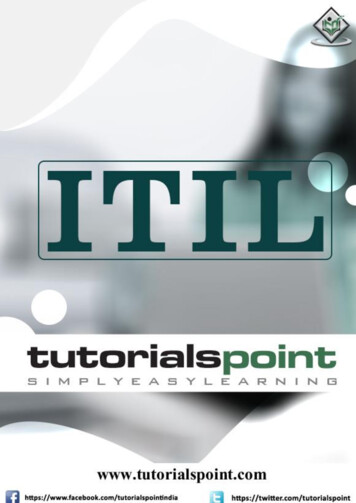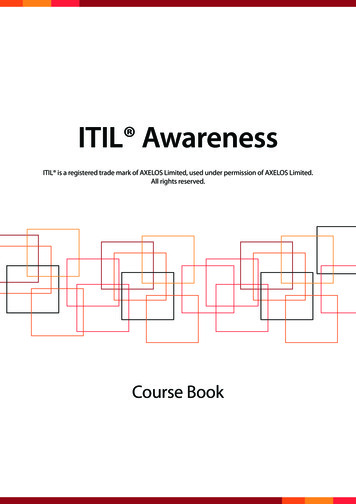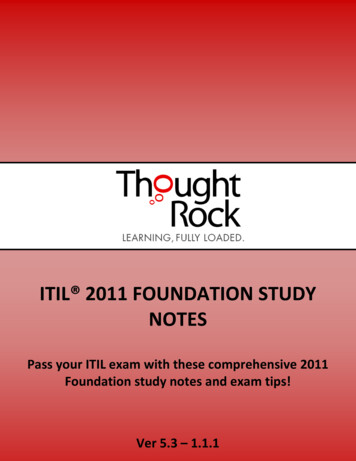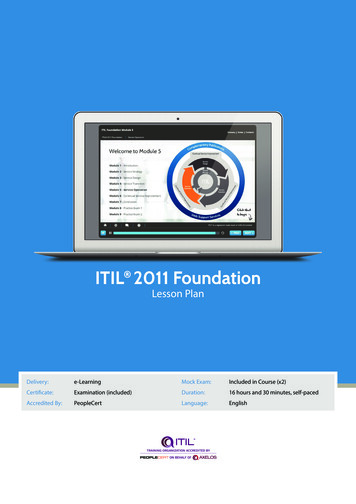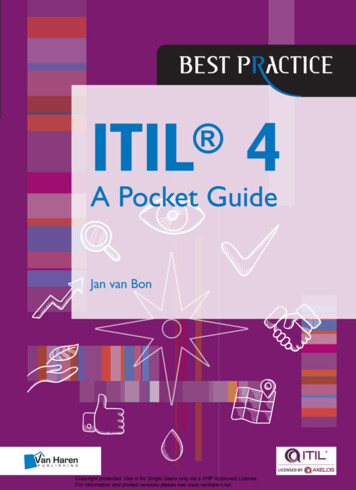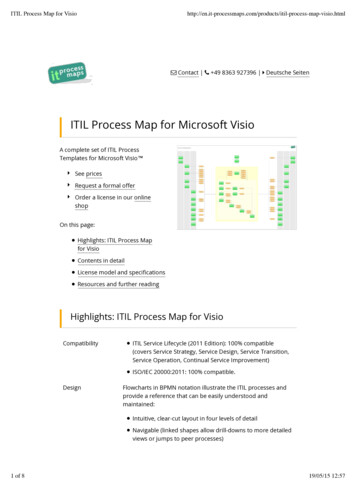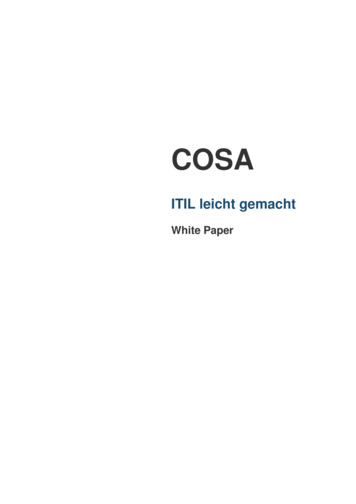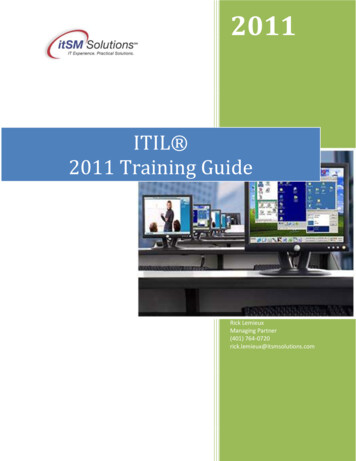
Transcription
2011ITIL 2011 Training GuideRick LemieuxManaging Partner(401) 764-0720rick.lemieux@itsmsolutions.com
ContentsIntroduction . 4ITIL Defined . 4Service Operation (SO) . 4Service Transition (ST). 5Service Design (SD) . 5Service Strategy (SS). 5Continual Service Improvement (CSI) . 5ITIL 2011 . 5ITIL 2011 - Service Strategy . 5ITIL 2011 - Service Design . 5ITIL 2011 - Service Transition . 6ITIL 2011 - Service Operation . 6ITIL 2011 - Continual Service Improvement . 6ITIL Certifications . 6ITIL Foundation Certification. 7ITIL Intermediate - Lifecycle Specialist . 7ITIL Intermediate - Capability Specialist. 7ITIL Managing Across the Lifecycle (MALC) . 8ITIL Training Delivery Methods . 8ITIL Classroom or Virtual Classroom Training . 9ITIL Blended Learning Training Programs . 9ITIL Online Self-Paced Certification Programs . 10ITIL Exam Options. 10ITSM Education Modeling Tools . 12ITIL Certification Roles & Responsibilities . 14ITIL Service Operations Team . 14ITIL Service Transition Team . 14ITIL Service Strategy & Design Team . 15ITIL Continual Service Improvement Team . 15ITIL Expert . 16
ITIL Class & Exam Specifications . 18ITIL Certification Roadmap & Credit Profiler . 19itSM Solutions Contact Information . 21
IntroductionitSM Solutions is a CSME accredited training organization (ATO) and a PMI registered educationprovider (R.E.P.) specializing in the development of accredited and custom ITIL/ITSM trainingcontent that can be delivered in a classroom, virtual classroom (webex), online self-paced videoclassroom (PC, Smartphone, Tablet) or blended classroom that using a using a highly optimized,delivery and student management model (self-paced videos instructor led review session student tracking & reporting)All of the ITIL certification programs offered by itSM Solutions enable students to accumulate ITILcredits that can be applied towards ITIL Expert status with APMG along with PDU credits that can beapplied to maintaining ones PMP status with the Project management Institute (PMI ).ITIL DefinedAccording to the official ITIL site (www.itil-officialsite.com), ITIL is the only consistent andcomprehensive documentation of best practice for IT Service Management. Used by thousands oforganizations around the world, a whole ITIL philosophy has grown up around the guidancecontained within the ITIL books and the supporting professional qualification scheme.ITIL consists of a series of books giving guidance on the provision of quality IT services, and on theaccommodation and environmental facilities needed to support IT. ITIL has been developed inrecognition of organizations growing dependency on IT and embodies best practices for IT ServiceManagement.The ethos behind the development of ITIL is the recognition that organizations are becomingincreasingly dependent on IT in order to satisfy their corporate aims and meet their business needs.This leads to an increased requirement for high quality IT services.ITIL is supported by a comprehensive qualification scheme along with a network of accreditedtraining, consulting and technology providers operating across the globe.The primary benefit coming out of most ITIL projects is a significant reduction in IT's Total Cost ofOwnership (i.e., operations cost) along with the ability to deliver reliable, high value services to theirclient base. Today, ITIL best practices have been adopted by organizations of all sizes includingDisney, IBM, Caterpillar, Shell Oil, Boeing and governments across the globe.The five Books of ITIL are:Service Operation (SO)Service Operation introduces, explains and details delivery and control activities to achieveoperational excellence on a day-to-day basis. Readers will find many of the familiar processes fromthe former service support and service delivery books, which have been updated where necessary.
Service Transition (ST)Service Transition provides guidance and process activities for the transition of services in theoperational business environment. It covers the broader, long-term change management role,release and deployment practices, so that risks, benefits, delivery mechanisms and the support ofongoing operational services are considered.Service Design (SD)In order to meet the current and future business requirements, Service Design provides guidance onthe production and maintenance of IT policies, architectures, and documents for the design ofappropriate and innovative IT infrastructure service solutions and processes.Service Strategy (SS)A view of ITIL that aligns business and IT so that each brings out the best in the other. It ensuresthat every element of the Service Lifecycle is focused on customer outcomes and relates to all thecompanion process elements that follow. Subsequent titles in the core set will link deliverables tomeeting the business goals, requirements and service management principles described in thispublication.Continual Service Improvement (CSI)Alongside the delivery of consistent, repeatable process activities as part of service quality, ITIL hasalways emphasized the importance of continual improvements. Focusing on the process elementsinvolved in identifying and introducing service management improvements, this publication alsodeals with issues surrounding service retirement.ITIL 2011The most current release of the library is titled ITIL 2011. It was released to the market on July 29th,2011. The 2011 edition provides the following updates to ITIL 2007ITIL 2011 - Service StrategyThe concepts within the publication have been clarified, without changing the overall message. Theupdated publication includes more practical guidance and more examples where relevant. The newlydefined process of strategy management for IT services is responsible for developing andmaintaining business and IT strategies, and there are now separate descriptions of businessstrategy and IT strategy. Financial management has been expanded, and business relationshipmanagement and demand management are now covered as processes.ITIL 2011 - Service DesignThroughout the updated ITIL Service Design publication, there has been particular focus onalignment with ITIL Service Strategy. A number of concepts and principles have been clarified, mostsignificantly the flow and management of activity throughout the overall service design stage with theaddition of the ‘design coordination’ process. Other significant clarifications include the five aspects
of service design, the design of the service portfolio and the terminology related to views of theservice catalogue.ITIL 2011 - Service TransitionThe structure, content and relationships of the configuration management system (CMS) and serviceknowledge management system (SKMS) have been clarified to help the reader to understand thesekey concepts. There is new content explaining how a change proposal should be used. Theevaluation process has been renamed ‘change evaluation’ and the purpose and scope have beenmodified to help clarify when and how this process should be used. The service asset andconfiguration management process has additional content relating to asset management, and thereare improvements in the flow and integration of a number of processes, including changemanagement, release and deployment management, and change evaluation.ITIL 2011 - Service OperationProcess flows have been updated or added for all processes including request fulfillment, accessmanagement and event management. Key principles – including guidance around service requestsand request models, and proactive problem management – have been clarified. The publication hasbeen updated to explain how basic events flow into filters and rule engines to produce meaningfulevent information. The relationship between application management activities versus applicationdevelopment activities is also clarified. Other clarifications include an expanded section on problemanalysis techniques, procedure flow for incident matching and further guidance for escalatingincidents to problem management. In addition, the guidance for managing physical facilities hasbeen expanded.ITIL 2011 - Continual Service ImprovementThe seven-step improvement process – and its relationship with the Deming ‘Plan-Do-Check-Act’cycle and knowledge management – has been clarified. The CSI model has been renamed the CSIapproach and the concept of a CSI register has been introduced as a place to record details of allimprovementInitiative’s within an organization. Minor changes have been made throughout the book to clarify themeaning and to improve readability. Particular emphasis has been made on documenting theinterfaces from CSI to other lifecycle stages.More details on the 2011 changes can be found on the official ITIL site at http://www.itilofficialsite.com/ITIL CertificationsToday, ITIL offers a total of 11 certifications to the IT community. ITIL has accommodations in itssyllabi to support delivery in a classroom or virtual classroom using an accredited instructor or inself-study or blended learning environment using a combination of online self-paced training
programs combined with accredited instructor or mentoring resources. Listed below is a briefdescription of the training programs currently being offered to the market place.ITIL Foundation CertificationThe foundation-level certification program targets IT professionals looking to become a generalpractitioner in the practice of IT Service Management. While these practitioners have a generalunderstanding of ITSM, they have a limited knowledge of any specific process, function or servicelifecycle area. This is the first stop for those looking to become ITSM Specialists, Practice Managersor Experts. Although not required, candidates are highly encouraged to complete a classroom oronline program prior to sitting for the exam. The exam is forty question multiple choice and can betaken in a classroom, online with a web cam proctor or in an examination institute testing center.Candidates will be awarded two ITIL credits and in most cases 18 PDU’s upon successfulcompletion of the Foundation exam.ITIL Intermediate - Lifecycle SpecialistThe lifecycle certification series targets individuals looking to specialize in one or more of the fiveITIL Lifecycle practice areas. Historically, these roles involve individuals from the Planning, Designand Improvement areas within the IT Engineering, Application and Project/Program Managementorganizations. Candidates must hold a ITIL V3 Foundation certificate plus successfully complete aclassroom or online training program to sit for the Lifecycle exams. The exams are eight questioncomplex multiple choice and can be taken in a classroom, online with a web cam proctor or in anexamination institute testing center. Candidates will be awarded four ITIL credits and in most cases22 PDU’s every time they successfully complete a Lifecycle exam.Lifecycle certification classes include: Service Operation (SO), Service Transition (ST), ServiceDesign (SD), Service Strategy (SS) and Continual Service Improvement (CSI).ITIL Intermediate - Capability SpecialistThe capability certification series targets individuals looking to specialize in one or more of the fourITIL Capability practice areas. Historically, these roles involve individuals from the serviceimplementation, maintenance and support areas within the IT Implementation and Operationsorganizations. Candidates must hold a ITIL V3 Foundation certificate plus successfully complete aclassroom or online training program to sit for the Capability exams. The exams are eight questioncomplex multiple choice and can be taken in a classroom, online with a web cam proctor or in anexamination institute testing center. Candidates will be awarded four ITIL credits and in most cases38 PDU’s every time the successfully complete a Capability exam.Capability certification classes include: Operational Support & Analysis (OSA), Release, Control& Validation (RCV), Planning, Protection & Optimization (PPO), Service Offerings & Agreements(SOA).
ITIL Managing Across the Lifecycle (MALC)The Managing Across the Lifecycle (MALC) program leads to the ITIL V3 Service Manager Expertcertificate. This capstone certification completes the Lifecycle and Capability streams by focusing onthe ancillary knowledge required to implement and manage the necessary skills associated with theuse of the Lifecycle practices.Candidates must have accumulated 17 ITIL credits by completing a series of Lifecycle or Capabilitycertification programs to qualify to sit for the exam. The exam is an eight question complex multiplechoice and can be taken in a classroom, online with a web cam proctor or in an examination institutetesting center Candidates will be awarded five ITIL credits and in most cases 38 PDU’s uponsuccessful completion of the MALC exam.ITIL Training Delivery MethodsThere has been lots of discussion lately about what ITIL training method is best to learn from. Thereare those who say classroom is best because it's where you have direct access to an experiencedinstructor as well as other IT professionals willing to share their thoughts and experiences. There areothers who say e-learning is the way to go as it provides the student with scheduling and learningflexibility plus online mentoring services at a low price. There are others who say blended learning isbest as it provides the best of both instructor led classroom and e-learning. The bottom line is they'reall good as each delivery method is a nail to someone's training hammer. Listed below is a detaildescription of each delivery method along with a summary of how each method impacts training,travel and time out of the office budgets along with the student's ability to pass the exam on the firsttry (i.e., return on investment).The Three T's and one R of ITIL TrainingThere are four basic things training coordinators need to think about when connecting a student withan ITIL training delivery method.The first is Training budget. It makes no sense to go shopping at Tiffany's if you only have a dollar inyour pocket.The second is Travel. Most companies have put a hold on travel until the economy gets better. Mygut tells me that even when it gets better there will still be a hold on it especially when managementdiscovers that things still get done without people jumping on airplanes.The third is Time out of the office. The downturn in the economy has forced companies into aposition of doing more with less. With that being the case it's almost impossible for anyone to leavefor a couple of days let alone a week.The fourth is Return on Investment (ROI). That is, if employers (or wives) are paying for the trainingthey want some assurance that the student will pass the exam on the first try and that he or she willreturn with knowledge they can be used on the job.Listed below is a summary of the ITIL training methods available, their impact on a student’s training,travel and time out of the office budgets and their value in helping a student retain the content andpass the exam on the first try.
ITIL Classroom or Virtual Classroom TrainingITIL classroom certification programs are delivered by an accredited instructor to groups of studentsassembled in a physical or virtual (webinar) classroom with the exam being administered on the lastday of the program however students willing to use a new web cam proctoring method nowhave the option to set them up on their own. Training options include: Public, open enrollment classes delivered in a training center to a group of students Public, open enrollment virtual (webinar) classes delivered online to a group of students Corporate classes delivered onsite to a group of six or more students Corporate virtual classes delivered online to a group of six or more students Courseware licensing programs for IT organizations looking to deliver their own programBudget & Productivity Impact Training Budget - This is the most expensive solution in the market today due to itssignificant expense structure (venue, instructor, operational overhead etc.) Travel Budget - Unless you can find a virtual or locally hosted class some travel dollars willbe required. Time out of the Office - Plan three days for Foundation and the Service Lifecycle classes andfive days for Capability and Managing Across the Lifecycle. Content Retention / Exam Pass - This is one of those depend situations. That is, if theinstructor is good and the student follows all the rules (i.e., reads the corresponding ITILbooks, studies in the evening etc.) the likelihood of passing the exam is in alignment with theaverage international pass rates of 77.5%ITIL Blended Learning Training ProgramsITIL blended learning training programs use a combination of online self-paced training programscombined with accredited instructor or mentoring resources plus student management services.Exams are typically delivered on the last day of the program however students willing to use a newweb cam proctoring method now have the option to set them up on their own. Training optionsinclude: Public, open enrollment classes delivered in a training center to a group of students Public, open enrollment virtual (webinar) classes delivered online to a group of students Corporate classes delivered onsite to a group of six or more students Corporate virtual classes delivered online to a group of six or more students Courseware licensing programs for IT organizations looking to deliver their own programsBudget & Productivity Impact Training Budget - With minimal instructor and venue expense, this delivery method tends toprice out somewhere between classroom and online self-paced training.
Travel Budget - If the instructor led review session is delivered online the impact to thebudget is zero. If delivered in a classroom, the impact will be minimal based on the reducednumber of days required for the instructor to be onsite. Time out of the Office - Plan one day for Foundation and two days for all other programs. Content Retention / Exam Pass - This program provides a lot of one-on-one support to helpstudents retain the content and pass the exam on the first try. In a pilot program with aFortune 100 company this approach is producing pass rates at the 95% level with averagestudent scores coming in at 85 %ITIL Online Self-Paced Certification ProgramsITIL self-paced certification programs are delivered online using a self-paced, streaming video ortraditional e-learning format with support from ITIL Experts and other students operating within asocial network or proprietary support group. With this approach students are in charge of setting uptheir exam schedule. Training options include: Online self-study training videos or e-learning programs delivered direct to a student's PC,smartphone or tablet Corporate self-study e-learning training programs delivered over the corporate intranetBudget & Productivity Impact Training Budget - This delivery method tends to be the least expensive as everything(lectures, courseware, mentoring & exams) is delivered online. Travel Budget - This delivery method has zero impact on the travel budget Time out of the Office - Dependent on how the students structure their self-study schedulethis delivery method may or may not require any time out of the office. Content Retention / Exam Pass - This program provides a lot of one-on-one online support tohelp students retain the content and pass the exam on the first try. Our experience to datewith this approach is showing pass rates at the 85% level with average student scorescoming in the 80% rangeITIL Exam OptionsAll organizations approved by APM Group Limited (the official ITIL Accreditor) as examinationinstitutes (EIs) are audited by independent auditors appointed by APM Group in accordance with theprinciples of international best practice standards. If the systems used by the applicant organizationsalign with these guidelines, they will be granted permission to administer the scheme for ITILaccreditation and qualifications and will also be offered a place on the Qualifications Board. Underthe contracts signed with APM Group, EIs are allowed to undertake the following activities: Approve training organizations through the standards and mechanisms audited and agreedby APM Group.
Administer examinations via those organizations they have approved using the standardsand mechanisms agreed by APM Group.EIs are permitted to operate an ITIL examination scheme through a network of Accredited TrainingOrganizations, and Accredited Trainers with Accredited materials.All EIs also have representation on the ITIL Qualifications Board; the governance and standardssetting body for the ITIL scheme.The selection of an Examination Institute often revolves around its geographic proximity, processesfor qualifying and providing examination proctors, and ability to handle special examinationrequirements.The thing to remember when selecting an examination institute is that they all distribute thesame exams globally. The key difference comes down to the followingExam Delivery Methods - With ITIL V3 supporting multiple training delivery models it's important forthe EI to support easy to use delivery methods that align with the training model the student hasselected. One thing to remember is to get the details behind their offering as they are not all createdequal. Delivery models include:oooPublic Testing (PT) centers offering both paper based and online examsOnsite Testing (OST) using either paper based or online examsOnline Testing (OLT) online exams using an online web cam proctorCustomer Service - There are two schools of thought on customer service in the EI world. Someleave everything up to the student to coordinate while others provide support services to assist thestudent throughout the process of scheduling an exam. Other services include certificate and ITILpin distribution.The current Examination Institutes are:1. APMG-UK - APMG specializes in the accreditation and certification of organizations, processesand people, offering global accreditation and examination services for training providers. Examdelivery methods include PT, OST, OLT2. CSME - CSME has been working to promote IT Professionalism in the US and the Americas forover half a decade. While we have been focused on ITIL to date, CSME is positioned to supportall IT Certification schemes that promote IT Professionalism. CSME is committed to maintainingand advancing the integrity of the examination processes for all IT Professional Certifications.We do this while always putting customer service first. Exam delivery methods include PT, OST,OLT3. EXIN - The Examination Institute for Information Science in the Netherlands (EXIN) is a global,independent IT examination provider. EXIN establishes educational requirements and developsand organizes examinations and learning tracks in the field of IT. Exam delivery methods includePT, OST4. ISEB - The Information Systems Examination Board (ISEB) is a wholly owned subsidiary of theBritish Computer Society. The ISEB provides industry recognized qualifications that measure
5.6.7.8.9.10.competence, ability and performance in many areas of IT, including ITIL. Exam delivery methodsinclude PT, OSTLCS - Loyalist Certification Services (LCS) is a premier deliverer of ITIL certification exams inNorth America. Exam delivery methods include PT, OST, OLTDANSK IT - With more than 6,000 members, DANSK IT is a leading interest organization for ITprofessionals in Denmark. Its core activities revolve around member networks, conferences,courses, certification programs and IT political advice to the Danish Government and itsagencies. Founded in 1958, DANSK IT is among the first IT societies in the world. Exam deliverymethods include PT, OSTDF Certifiering AB - DF Certifiering AB (DFC), is a wholly owned subsidiary to Dataföreningeni Sverige, the Swedish Computer Society with 26,000 IT professionals as members in Sweden.DFC's role is to give accreditation to training providers and certify IT. DFC also providesproducts in the field of Information Security and self assessing tests for e-Citizens.Exam deliverymethods include PT, OSTCERT IT - Cert-IT was founded by the developers of the IT Training System. We are the firstaccredited certification body for IT professionals worldwide. We use this competence ofdevelopment as a clear advantage. Exam delivery methods include PT, OSTPEOPLECERT - Through 8,850 examination locations worldwide and with more than 600,000certified individuals and 3,000,000 exams to date, PEOPLECERT Group, the experts in certifyingprofessionals, offers ITIL certifications, as well as other globally recognised, independentcertifications that evaluate competence, know-how and expertise and are key to today'scompetitive, performance-driven business environment. Simple, fast, reliable. Exam deliverymethods include PT, OST, OLTTuv sud Akademie - The TUV SUD Group is well known for consulting, testing, certification andtraining on behalf of industry, trade and commerce, public institutions and private individuals.TUV SUD creates increased safety and added economic value by supporting the competitivestrength of our customers through the world. TUV SUD Mission: Choose certainty. Add value.Exam delivery methods include PT, OSTITSM Education Modeling ToolsITER is a five step ITSM transformation education roadmap and modeling system built around thekey principles outlined in Kotters eight step change process for organizational transformation. Thefive phases of ITER are: Awareness - Introduce the concepts of ITSM & ITIL to the leadership team and stakeholdersCommitment - Select a team to create the plan & vision then train them to become theevangelistsConditioning - Getting IT and the lines of business ready for IT transformationEmpowering - Empower and reward those who have embraced the vision with the advancedtraining & certification that will enable them to become part of the Planning, Design,Implementation, Operation and Improvement teams.Institutionalization - Establish new HR policies in the areas of recognition, rewards, hiring,promotions & role-based career development.
ITER provides enterprises with a structu
ITIL consists of a series of books giving guidance on the provision of quality IT services, and on the accommodation and environmental facilities needed to support IT. ITIL has been developed i


